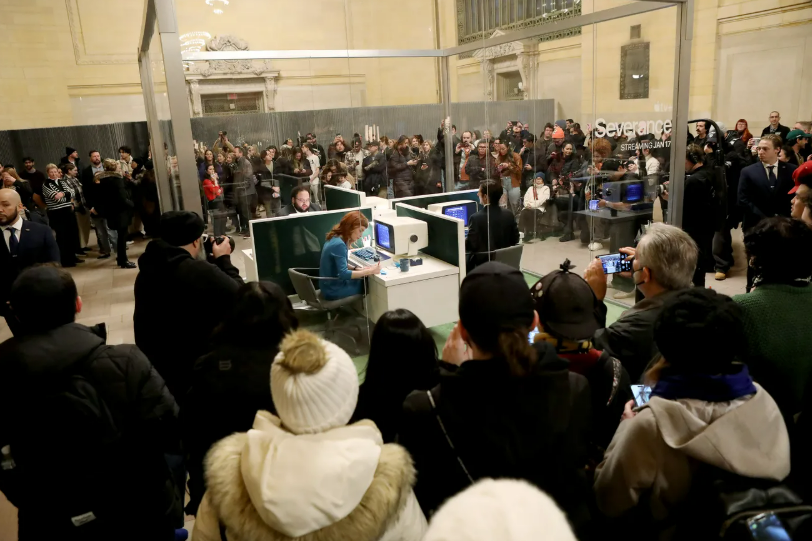The Severance effect
A masterclass in making fiction feel real
Credit: AP News
Some shows rely on trailers. Others on billboards. But Severance? It wormed its way into our reality, making us question whether we were watching a corporate nightmare or living in one.
@apple TV+ didn’t just promote Severance, they activated it. They turned a slow-burn psychological thriller into a multi-dimensional experience that blurred the line between fiction and reality. And in doing so, they delivered one of the most compelling marketing campaigns in recent memory.
Here’s how they did it and why brands should be taking notes.
1. The Grand Central activation: Turning commuters into unwilling extras
New Yorkers are famously unbothered by weirdness. But even they had to do a double take when a group of the key Severance cast members, dressed in office attire, set up a temporary desk station at Grand Central Terminal in a fishbowl-like fashion.
The activation wasn’t flashy. Just an unsettling display of robotic office drones completing everyday office tasks, set inside a glass box pop-up installation in the middle of one of the busiest places in the world, mirroring the very premise of Severance.
Lesson: Make your audience feel something first, explain later.
In a world drowning in ads, Severance proved that discomfort is memorable. They let the confusion simmer for the commuter unfamiliar with the show, prompting passersby to Google, share, and ask: What the hell did I just witness?
That’s free buzz, and the best kind.
Read more on the Grand Central stunt
Credit: USA Today
2. The Lumon Industries LinkedIn page: Corporate horror, but make it HR-compliant
What’s the best way to promote a dystopian corporate thriller? By acting like it’s real.
Apple created an actual LinkedIn page for @lumonindustries, the fictional (and deeply sinister) corporation at the heart of Severance. And they played it straight.
Job postings for vague-sounding roles like "Macrodata Refinement Specialist”, jarring employee testimonials drenched in ominous corporate jargon, tokenistic milestone celebrations and quotes from the organisation’s cult-like founder. The LinkedIn account is drowning in a perfectly dull, soul-sucking tone that screams, "You’re already working here. You just don’t remember signing the contract."
Lesson: World-building isn’t just for movies - it’s for marketing.
Most brands struggle to make their LinkedIn pages interesting. Severance turned theirs into a psychological experiment. And guess what? People engaged. They followed. They shared. They talked. Just like we are at @wearebrooklyn.
Want your marketing to hit different? Don’t just sell a story - build a world.
Check out Lumon Industries on LinkedIn
Credit: Apple World Today
3. The Tim Cook visit: When fiction and reality collide
Tim Cook, Apple’s CEO, casually strolling through the Severance set at Lumon Industries? That’s marketing gold.
It was just meta enough to make fans spiral into conspiracy mode. Was he just visiting? Was he checking in on Lumon’s operations? Is Severance actually a documentary?
The internet ran with it, and Apple barely had to lift a finger.
Lesson: The best marketing is when the audience does the work for you.
Tim Cook’s visit was more than about selling Severance. It was about playing into the mystery. Fans connected the dots themselves, turning a simple CEO walkabout into a viral moment.
Your brand doesn’t always need a direct CTA. Sometimes, the most powerful strategy is simply placing the right person in the right place at the right time, and letting the internet do the rest.
Watch Tim Cook visit Lumon
Credit: IMDb
What Severance did wasn’t new. It was just better executed than most.
They didn’t just promote the show. They let people stumble into it and figure it out themselves.
They didn’t just advertise. They extended the world beyond the screen.
They didn’t over-explain. They left just enough mystery for audiences to fill in the blanks.
And that’s why Severance didn’t just win viewers. It won believers.
So, ask yourself: Is your brand telling a story? Or is it living one?
If it’s the latter, you’re on the right track. If not, talk to us.
Credit: Collider





